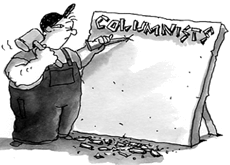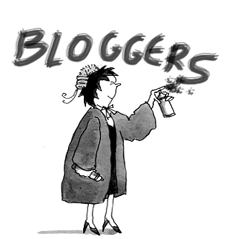Viticulture in Van Diemen's Land
 Wendler on Wine •
Wendler on Wine •  Tuesday, June 16, 2015
Tuesday, June 16, 2015 Lawyers and the grape ... Guy Green and William Cox - Tasmania's vine growing chief justices, who managed not to produce any wine ... Gabriel Wendler reviews a painstaking history of Tasmanian wine

Novelist Anthony Burgess considered wine-worshipping the "most vulgar of idolatries".
There is nothing vulgar or idolatrous about Tony Walker's comprehensive and long-awaited Vintage Tasmania: The Complete Book of Tasmanian Wine with an introduction by Australia's eminent wine educator, James Halliday.
In 1978 the great Len Evans could only identify and review five vineyards in Tasmania - La Provence, Moorilla, Pipers Brook, Windermere and Heemskirk. Nevertheless, Evans correctly predicted, "winemaking in Tasmania is poised for expansion".
Seven years later Tasmania had 12 winemaking estates comprising approximately 74 hectares of vines producing around 20,000 cases of wine annually. By 1998, wine judge Phil Laing's pocket monograph reviewed 76 Tasmanian wineries.
Today there are almost 100 wineries across seven regions of Tasmania - North West, Tamar Valley, Pipers Brook, East Coast, Coal River Valley, Derwent Valley and Southern Tasmania.
Bartholomew Broughton was Tasmania's first vigneron arriving in Hobart in 1820. He had been sentenced to transportation for embezzlement. By 1826 Broughton, a ticket-of-leave man, was able to offer for sale "200 gallons of grape wine in casks of 20 gallons each", made from grapes grown at Prospect Farm, New Town.
Lamentably, two years later Broughton was dead. He was just 32 years of age. His obituary, published in the Hobart Town Gazette, informed readers that:
"His elegant and productive farm at New Town with its primitive Tasmanian vineyard was not on a sufficient scale for his enterprising views ..."
The Hobart Town Almanac of 1829 asserted that, "since the death of Mr Broughton the making of wine has been abandoned". Prospect Farm was purchased by Captain Charles Swanston who continued to make wine there, successfully.
Also around this time vine cuttings sent from Tasmania to Victoria and South Australia, "played a role in the establishment of the first vineyards in both states".
There is detailed information in the book of the important contributions made to the viticultural history of Tasmania by Dr Matthias Gaunt and horticulturist Thomas Giblin.
An entire chapter is devoted to the circumstances of the 1884 "Bernacchi experiment", a viticultural episode of colour and fascination that occurred on Maria Island, a former whaling station and penal settlement off the east coast of Tasmania.
In 1884 Signor Angelo Bernacchi, his wife and three children, arrived in Launceston from England. He had been a successful silk merchant in Manchester and was a man practised in animated persuasion. He was able to convince Tasmanian authorities to agree to a lease of Maria Island for the establishment of sericulture and viticulture.
"Bernacchi accompanied by E.A. Counsel of the Lands Department travelled to Swansea on the East Coast looking for suitable land. Their horse went lame and to pass the time while the horse rested, they took a boat to Maria Island. Visiting the old penal settlement at Darlington, Bernacchi discovered a peach tree bearing fully ripe fruit and concluded that the island would be climatically perfect for his purpose."
In 1885 cabernet sauvignon vines were planted on Maria Island and eventually wine was made. Unfortunately the viticultural venture failed. Walker says:
"Bernacchi has been harshly judged by history and seen as something of a charlatan entrepreneur, an opportunist skilled at taking advantage of politicians and investors. In fact Bernacchi should be seen as a visionary who realized Tasmania's potential for viticulture and whose fault was the wrong choice of vineyard site."
By 1919, "Tasmania was not to see another vineyard for almost 60 years".

Walker rightly dedicates his book to the four pioneers who resurrected Tasmanian viticulture, Jean Miguet, Claudio Alcorso, Graham Wiltshire and Dr Andrew Pirie.
French civil engineer Jean Miguet, along with his wife Cecile, are described as: "Tasmania's first vignerons of the modern era." In 1956 the Miguets established a vineyard adjacent to Lilydale some 18 kms northeast of Launceston. They named the estate La Provence.
In 1958 polymath Claudio Alcorso borrowed an aboriginal word meaning "rock by the water" and established Moorilla vineyards at Berridale.
In 1966 Graham Wiltshire co-founded a west Tamar Valley vineyard at Legana and named it after Abel Tasman's Flagship, Heemskirk.
Andrew Pirie utilized his scientific training and knowledge of the climatic regimes of Burgundy and Champagne to identify the most apposite climatic and soil regimes in Tasmania conducive to cool climate viticulture.
In 1974 Pirie and his brother established the Pipers Brook vineyard. His wine label borrowed convict Joseph Lysett's engraving of a pastoral scene depicting shepherds on Macquarie Plain with Tasman's Peak in the distance.
Walker's book teems with historical photographs and documents concerning the evolution Tasmania's wine industry.
There is mention of lawyers who have been involved in wine making. Sir Guy Green and William Cox, eventually appointed 10th and 11th chief justices of Tasmania, planted a Tamar Valley hobby vineyard in the 1960s that ultimately did not produce any wine.
In the 1980s solicitor Graeme Lynch, as leader of Aberfeldy Cellars Wine Club, indefatigably promoted Tasmanian wine - and still does. Greg Mellick SC of Pressing Matters winery in the Coal River Valley is mentioned.
My taste memories of Tasmanian wine recall in particular the extraordinary 1984(Northern and Upper Slopes) and 1997 Pipers Brook Rieslings, the Moorilla Cabernet Sauvignon from the excellent 1988 vintage and the astonishing Winstead 2002 Reserve Pinot.
The epilogue, written by Dr Pirie, alleges the single most damaging retardant of the Tasmanian wine industry was "Prescott's research article of 1969 which inferred that Tasmania was too cold for viticulture".
The Complete Book of Tasmanian Wine is a valuable disquisition concerning viticulture and wine production on the wonderful island of Tasmania.
G.D. Wendler
 Map of Tasmania,
Map of Tasmania,  Wine
Wine 








Reader Comments